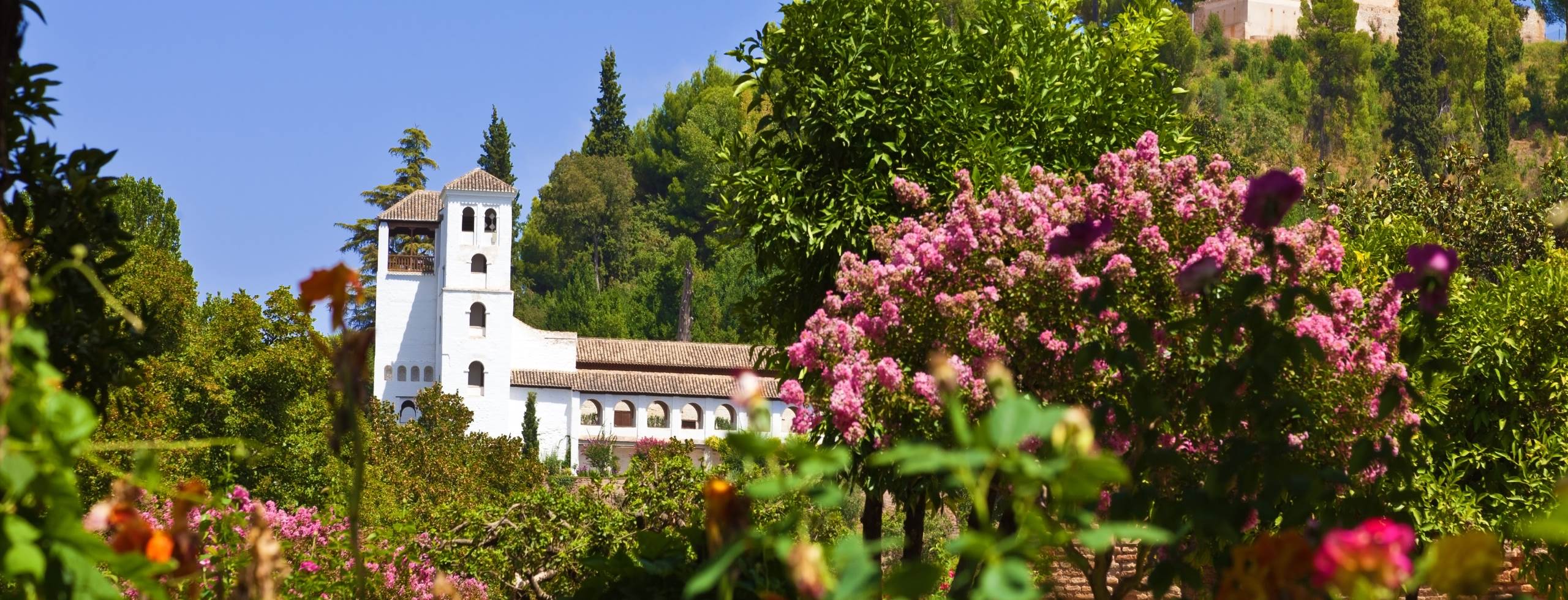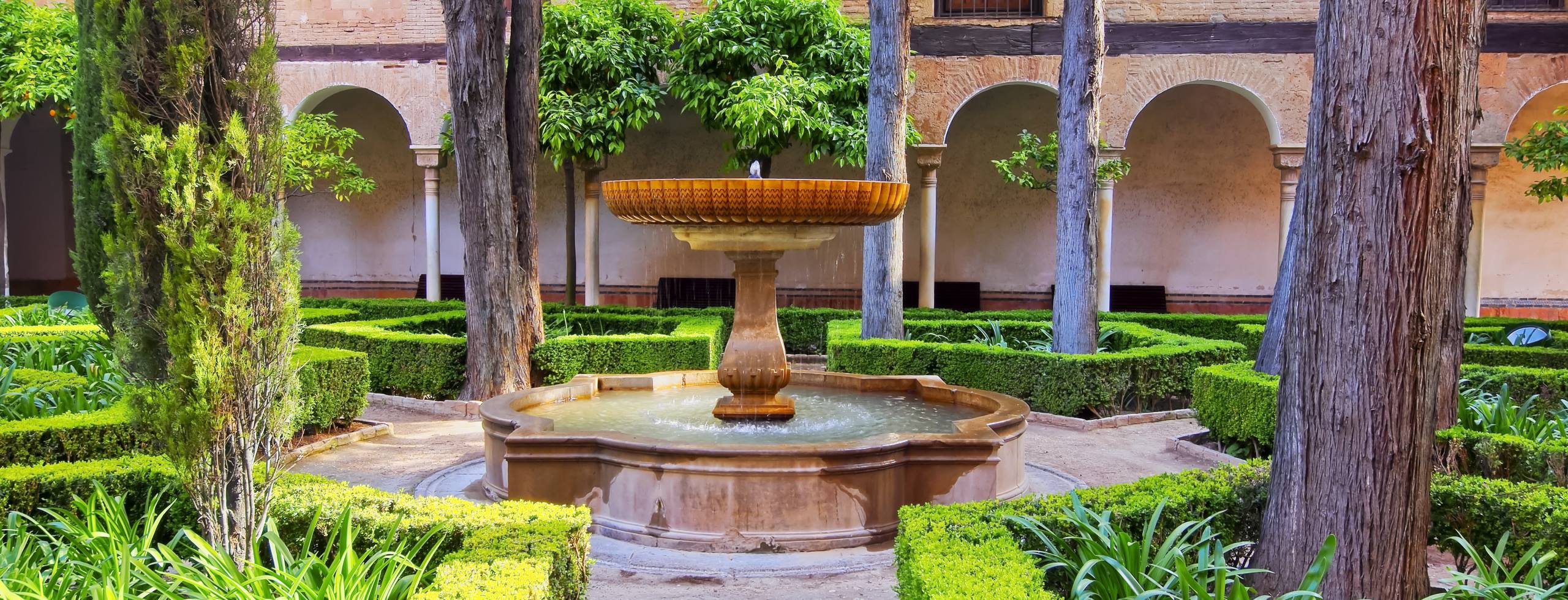If there’s one city not to be missed in southern Spain’s Andalusia region, it’s Granada. Located at the foot of the Sierra Nevada between two hills, it is one of Spain’s finest gems and indeed one of Western Europe’s most important cities for Arabic history and monuments; the Alhambra, the Generalife and the Albayzin are all UNESCO World Heritage monuments and truly places of legend! Granada was the last Spanish city to be retaken by the Catholic Monarchs and thus the whole city is synonymous with Arabic heritage. Because of its historical past, Granada has been an important cultural center for many centuries and still features a broad range of cultural events, including film, music and theatre festivals.
Route 1: Granada: The Alhambra and the Generalife
Unquestionably, one of the world’s most extraordinary and thus most visited sites is the structure that dominates the city of Granada – the medieval Moorish palace and its gardens known as the Alhambra or “Red Castle” in Arabic – and the Generalife from the Arabic meaning “architect’s garden”. It is important to mention that this site is so popular that during high season admission is often limited.
Although 11th century Moors built a basic castle on this hill, it was under the Nasrid dynasty of the 13th and 14th centuries that the distinctively Moorish complex was erected. It should be noted, however, that parts of it have been altered by later structures and modern renovations. The first major structure was built in the early 13th century by the Nasrids’ founder and was, not surprisingly, a fortress at the tip of the promontory overlooking the city; known as the Alcazaba, its towers provide a superb view of the city.
Enter the palace through the Puerta de la Justicia, and then head to the Palacios Nazaries, and its chamber known as the Mexuar; as the administrative quarters for the Muslims, Christians later converted it into a chapel, although it does retain its original intricately carved ceilings and other woodwork. From here pass into the Patio del Cuarto Dorado and then through the doorway to the right into the Patio de Arrayanes, named after the myrtle bushes that border the pool. Off to one side is the Tower of Comares, with its Hall of the Ambassadors; the largest hall in the Alhambra known for its colorful tiles, fabulous inlaid ceiling, and views; as the Christian monarchs’ throne room, it was where Ferdinand and Isabella agreed to support Columbus’ proposal to sail to the Indies.
From here proceed into the Patio de los Leones, its arcade supported by 124 delicate columns and with its alabaster fountain basin upheld by 12 lions that spouted water. Off to one side is the Sala de los Abencerrajes with its multicolored tiles and octagonal ceiling, while on the far end is the Sala de Dos Hermanas with its dazzling domed ceiling. The far end of this room provides a fine view over the lower garden, while off to the side is the Sala de los Reyes with its unusual painted leather ceiling. From here, a passageway leads past the domed roofs of the Muslims’ bathhouse and into rooms built in the early 16th century for Carlos I (better known as Charles V, Emperor of the Holy Roman Empire); it was in these rooms that Washington Irving stayed briefly in 1829 and was inspired to write his Tales of the Alhambra. It was this same Charles, who demolished a large section of the Alhambra to erect a massive palace in classical European Renaissance style.
From here descend to the gardens, first the Jardin de Lindaraja and then those facing the Palacio del Partal. This concludes your introduction to the Alhambra, but having come this far, you must also visit the Generalife; exit the Alhambra, follow the signs and walk along the fairly lengthy path to the Generalife. With its own palace and extensive gardens, pools, fountains and shade trees, the Nasrid rulers built the Generalife in the 14th century as a retreat from both the heat and the bustle of the Alhambra. The theater at the far end of the gardens is a modern addition, one of many alterations to the original Generalife.
Route 2: Exploring Granada
Although the Alhambra is undeniably Granada’s signature site, the city can claim a surprising number of other distinctive attractions. As in most great European cities, it is common to start a tour at the main cathedral; here in Granada it is the adjacent Capilla Real (the Royal Chapel) that is special and unique. Commissioned in 1504 it is the burial site of King Ferdinand and Queen Isabella – known in Spain as “the Catholic Monarchs” – work on it continued for decades and thus it combines Gothic and Renaissance elements in its design. Buried here is their daughter, Queen Joanna and her husband, Philip I of Castile.
Adjacent to the Royal Chapel is the cathedral; also commissioned by the Catholic Monarchs, it is a testament to the importance of acquiring Andalusia from the Moors. Constructed between the 16th and 18th centuries, it is a mix of styles resulting in an impressive if not especially important work of architecture. Adjacent to this is the Plaza Bib-Rambia and the Alcalcería, the Silk Exchange of the Moors; shops with both authentic crafts and tourist souvenirs now line its narrow streets. From here head to the Arab Baths off to the east below the Alhambra’s hill – it does require a walk of a few blocks, but is definite worth it! The baths, which are among the oldest structures in Granada, and the oldest of such baths in Spain, were closed after the Moors were driven out but they are now open and functioning under the name Hammams de Al Andalus. Nearby is the Palacio de Los Olvidados – the Palace of the Lost Ones – that opened in 2014 as a museum commemorating the important role of the Jewish community in the history of Granada.
At this point you will have entered into the part of the city known as the Albayzín, an old Muslim neighborhood on the hill facing the Alhambra; just strolling through the cobblestone streets and seeing the mansions, often surrounded by walls that enclose fine gardens, is satisfying and enchanting. If you are still up for more sightseeing, then you may want to visit the 15th-century Palacio de Dar-al-Horra and, near the top of Albayzín, the Colegiato del Salvador, the 16th century church on the site of a former mosque. Once at the top you should make your way over to the Mirador San Nicolás, offering street performers as well as great views of the city. Finally, those with still more energy can continue over to the northern hill known as the Sacromonte; its whitewashed caves carved into the natural rock serve as residences and shops for the gypsies who moved into this area after the expulsion of Moors in 1492. Since almost everyone who visits Granada wants to see one of the nightly performances of music and dance by today’s gypsies, a visit to the Sacromonte is a great idea for evening exploration.
Granada today is a vibrant city of some 240,000 people – 80,000 of whom are university students – with all the amenities of a modern city, but it is its historic past that draws so many visitors. As mentioned, the Muslims from North Africa dominated all of Andalusia for some five centuries; Granada and its surrounding territory actually remained under the rule of Muslims for another 250 years. This came about because Granada – although various peoples had long lived in this area – was founded in the early 13th century by a Muslim from North Africa who became known as King Muhammad; he set himself up independently from the Muslims who ruled the rest of Andalusia. Originally the rulers built little more than a walled fortress-town on the high ground here, but in the 13th century a new dynasty, the Nasrids, began to build the palace complex and citadel known today as the Alhambra. The Kings of Castile had re-conquered most of Andalusia by 1248 but it was on January 2, 1492 before the last Muslim ruler, known as Boabdil, was forced to surrender the city to King Ferdinand and Queen Isabella in a famous ceremony at the edge of Granada. As he rode off and turned to take a final look at the Alhambra, Boabdil is said to have wept, prompting his mother to say, “Thou weep like a woman for what thou could not defend as a man.”
At first the many Muslims living in Granada were allowed to practice their faith and maintain their customs, but by 1501 they were forced, along with all Muslims in Spain, to convert to Catholicism or emigrate. Those who stayed became known as Moriscos, after Moors, while the Jews of Spain who were also forced to convert were known as Marranos, which is Spanish for “pigs”. Granada was turned into a Spanish Catholic city, with mosques either destroyed or converted into churches. In the 1500s, work commenced on the city’s cathedral over the site of the Muslims’ great mosque. Although it began in the Gothic style, over time it was redesigned in Renaissance style and not finished until the early 18th century. Also built on the site of the great mosque was the Royal Chapel, an elaborate structure where King Ferdinand, Queen Isabella, their daughter Juana (“the Mad”) and her husband, Philip I are buried; its museum contains an important collection of European paintings.
Over the centuries, Granada’s “downtown” has developed like any modern city, but various neighborhoods have retained some of the characteristics and atmosphere associated with their residents. In particular, the Albayzin is located on a hill across from the Alhambra and was the old Moorish quarter; its buildings retain many Moorish elements and it is itself a UNESCO World Heritage Site. The Sacromonte, located on an extension of that hill, has many cave houses dug out of the hillside, which are populated by Gypsies; it is here that visitors can see flamenco dancing and music. The Bib-Rambla district includes an Arab bazaar in its narrow streets, while the Zaidin district is home to a large number of foreign-born immigrants as well as gypsies and is the site of a major open-air market on Saturdays.
Of course, it is the Alhambra that is most impressive to visitors, even though it isn’t a designated UNESCO World Heritage Site. A palace that includes both residential and governmental chambers, as well as a fortress, the Alhambra sits on a plateau of a hill overlooking the city and is completely surrounded by walls. Although a citadel was located here for many years, construction of the palace began in the late 13th century; the most ambitious buildings date from the 14th century and are distinguished by their spectacular Moorish-Islamic architectural elements, including tiles, Arabic calligraphy, and muqarnas (the stalactite decorated ceilings). The Alhambra itself is worth a trip to Spain!
Also not to be missed as part of the palace compound is the Generalife, with its formal gardens and fountains. As you wander through rooms and courtyards, and along the passageways and gardens, you will marvel not only at the craftsmanship and beauty, but also by the fact that this incredible Middle Eastern structure is located in Western Europe.



 View Map
View Map 

